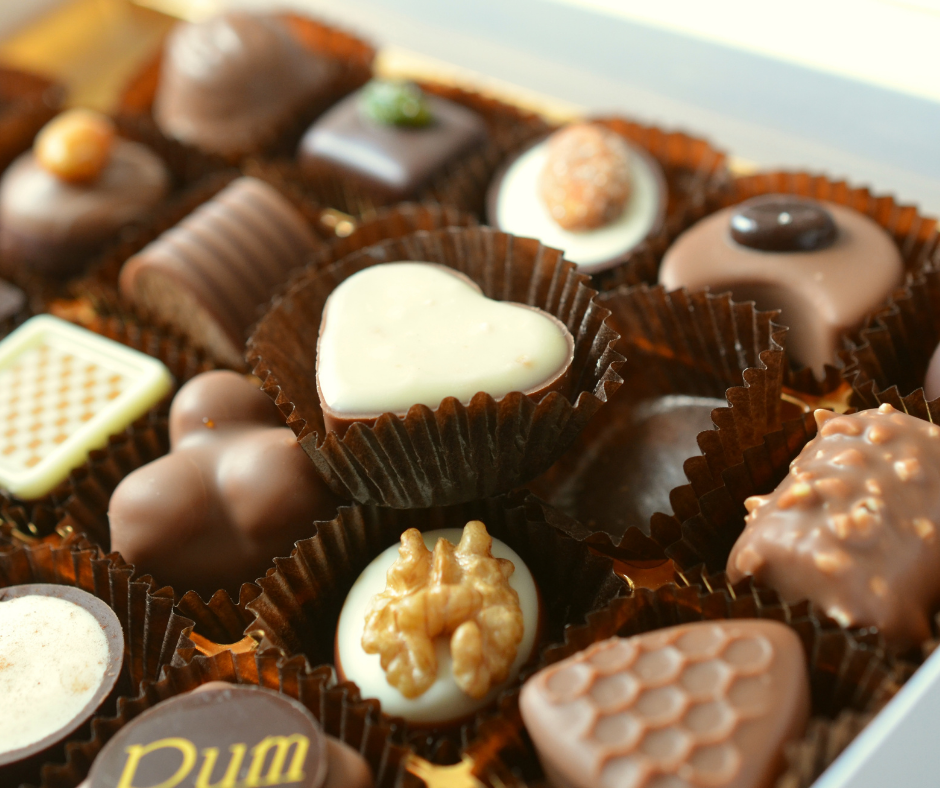By: Heidi Wagenbach
I adamantly told my boyfriend that I don’t want anything for Valentine’s Day. Personally, it’s a somewhat useless holiday that’s targeted at mushy-gushy couples to spend money on stuffed animals and flowers and of course, chocolate. I couldn’t care less about February 14th, but that doesn’t mean I will judge the couples who enjoy snuggling up with a cozy meal and glasses of wine to celebrate their relationship. I started thinking about how this tradition came along in the first place… how a heart-and-cupid filled holiday came to be associated with buying some sweets to gorge your lover with. So I went to trusty Google… and here’s what I found.
Science, Sales, and Sovereigns
Chocolate contains tryptophan (hey, that sounds familiar… remember my Does Turkey Make You Sleepy? blog?) and phenylethylamine, which are both chemicals that affect the brain’s pleasure and reward systems, but doctors agree that the amount is too little to have an effect. Dark chocolate is notorious for its health benefits, such as lowering the risk of heart disease and improving brain function. 58 million pounds of chocolate are purchased during Valentine’s week alone. In 2017, there were $695 million sales regarding chocolate gifts but we have to go back even further than three years. The connection between love and chocolate dates back to the Aztecs (check out my recent 10 Fun Facts About Hot Chocolate blog for more history) and apparently, Emperor Montezuma ate cocoa beans by the handful to “fuel his romantic trysts.”
The 1400s and Chaucer
In his 1382 poem Parlement of Foules, Geoffrey Chaucer references various early Christian martyrs named Valentine, describing the nature of love: “every bird cometh to choose his mate” on “seynt Voantynes day.” Wow, that’s bringing back memories of my good ol’ college days when I took a class all about The Canterbury Tales.
Valentine’s Day became a really popular late winter-early spring holiday; songs, poetry, and roses celebrated loving hearts, while sugar was still a precious resource not to be shared lightly.
Fast Forward 200 Years
Chocolate became popular in Western Europe after being introduced by Spanish explorers in the 16th century. It was so expensive that it was pretty much only consumed by the wealthy. Chocolate houses began to rival coffee houses as social gathering spots and in 1657, those shops advertised chocolate as “a Western Indian drink… cures and preserves the body of many diseases.” In France, Madame de Sevigne wrote about enormous chocolate consumption throughout the court at Versailles. Louis IV drank it daily and Madame du Barry used chocolate to stimulate lovers.
Marie Antoinette and the Victorian Era
Marie Antoinette married Louis XVI in 1770 and brought her own personal chocolate maker. That simple action created inspired recipes such as “chocolate mixed with orchid bulb for strength, chocolate with orange blossom to calm the nerves, or chocolate with sweet almond milk to aid the digestion.” Victoria became Queen in 1837, and technology transformed Valentine’s into a commercial success. Men enjoyed showering their crushes and lovers with gifts, however a 19th century commentator said that men knew chocolate was an instinctual way to someone’s heart. Men were able to demonstrate their tastes and expertises in regards to desserts by choosing the “right” box… yet etiquette books warned women to not accept gifts from men to whom they aren’t engaged.
Mid-1800s and Beyond
Halfway through the 19th-century, the British company J.S. Fry & Sons created their first ever chocolate bar, combining cacao powder, sugar, and cacao butter. Richard Cadbury, a “marketing genius,” introduced the first box of chocolates, deeming it the “Fancy Box” in 1861. Seven years later, his company produced its first heart-shaped box of fruit, ganache, and nut-filled chocolates in time for Valentine’s Day. The containers could be used afterwards to store love letters or other tokens after all the chocolates were eaten.
In the U.S., Hershey’s introduced their small and romantic Kisses in 1907. A little over a decade prior, Hershey’s was making caramels covered in chocolate, but this was revolutionary, the recognizable little treats said to be “a most nourishing food.” Russell Stover marketed their line of heart-shaped boxes across the midwest in the 1920s before becoming the #1 brand of boxed chocolates in the states. Their biggest seller was the “Secret Lace Heart,” adorned with… you guessed it, black lace.
So It’s Safe To Say…
That the tradition of Valentine’s and chocolates is relatively new, while the history of romance and chocolate is timeless. I think this is a holiday that will continue to thrive and stores will be decked out in red, pink, and white to encourage boyfriends, husbands, girlfriends, and wives to splurge a bit and treat their significant other to some chocolatey goodness. Some will succumb and others will avoid.
Sources:
Why Do We Give Chocolate On Valentine’s Day? Here’s The History Between Chocolate & Love
Why Do People Give Chocolate on Valentine’s Day?

